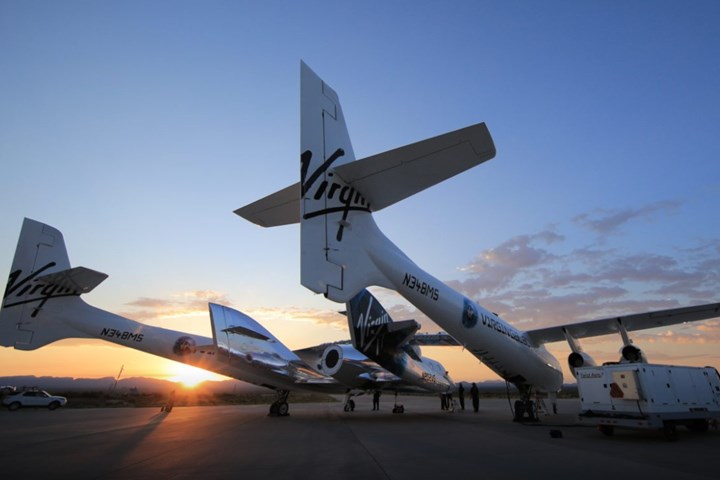SpaceShip Two prepares for first spaceflight
Virgin Galactic prepares its vehicles, pilots, team and facilities with rigorous pre-flight checks and objectives before the flight which will be carried out later this fall.

Photo Credit: Virgin Galactic
Virgin Galactic Holdings Inc. (Mojave, Calif., U.S.) reported on Oct. 14 that the company is preparing for the SpaceShipTwo’s first spaceflight from its operational base at Spaceport America (Las Cruces, N.M., U.S.) (see “SpaceShip Two completes second test flight”). Occurring later this fall, the flight will be crewed by two pilots and carry several research payloads (which are part of the NASA Flight Opportunities Program) in the cabin of VSS Unity. In these final preparations, Virgin Galactic says it is working through a number of rigorous steps to prepare the vehicles, pilots, team and facilities, ensuring that safety remains a top priority.
To ensure the pilots are well-prepared for the flight test objectives about to be conducted, Virgin Galactic notes the significant amount of training that has occurred in the company’s ground-based simulator, both with its own pilots, and those in sessions that are linked to the mission control room. Another training tool for the pilots included Virgin Galactic’s mothership vehicle, VMS Eve.
“VMS Eve has the ability to test pilot proficiency by simulating the glide and approach-to-land phase up flight for SpaceShip Two pilots,” chief pilot Dave Mackay explains. “The cockpit structure of Eve is almost identical to that of Unity: the same pilot seats and windows, as well as very similar flight controls and instruments. This, coupled with the fact that that with VMS Eve’s landing gear down, and one set of speed brakes out, it descends on the same flight path angle as SpaceShip Two, means that the crew can practice the identical approach and landing pattern to the one they will fly in Unity. This makes Eve a very valuable in-flight simulator.”
Virgin Galactic say preparing VSS Unity for flight also includes a “practice run” for the spaceship, as well as for the pilots and teams in mission control. This pre-flight check will put Unity through its paces on the ground by testing all systems prior to take-off to ensure functionality. This includes raising the feather, swinging the landing gear, firing the reaction control thrusters and sweeping the flight control systems through their full range of motion.
Further, with this flight being Virgin Galactic’s first spaceflight from Spaceport America, it reports that it has planned a full rehearsal of its spaceship propellant landing procedure. During this rehearsal, the company says it will perform a full tanking test, loading high-pressure helium and nitrous oxide into their respective spaceship tanks on-board VSS Unity. This particular rehearsal will provide the teams the opportunity to review the end-to-end execution of every step in the flight process to Spaceport.
Consistent with how Virgin Galactic conducted VSS Unity’s glide flights earlier this year, the company says all operations are following a set of stringent operational protocols that include changes to the work areas and procedures to enforce social distancing and universal mask usage, as advised by state guidelines.
Reporting it is still on track to meet its timeframe, Virgin Galactic expects its first spaceflight to occur later this fall. In September, the company disclosed, via its application for a multi-year Federal Communications Commission (FCC) license, that October 22, 2020, would be the opening of the company’s flight planning window. The company also says it includes preliminary test flight dates for its mothership, VMS Eve. While preparations are going well, Virgin Galactic states that it is not yet at the stage where it can confirm specific planned flight dates for either the VSS Unity or VMS Eve test flights.
Related Content
Combining multifunctional thermoplastic composites, additive manufacturing for next-gen airframe structures
The DOMMINIO project combines AFP with 3D printed gyroid cores, embedded SHM sensors and smart materials for induction-driven disassembly of parts at end of life.
Read MorePlant tour: Airbus, Illescas, Spain
Airbus’ Illescas facility, featuring highly automated composites processes for the A350 lower wing cover and one-piece Section 19 fuselage barrels, works toward production ramp-ups and next-generation aircraft.
Read MoreInfinite Composites: Type V tanks for space, hydrogen, automotive and more
After a decade of proving its linerless, weight-saving composite tanks with NASA and more than 30 aerospace companies, this CryoSphere pioneer is scaling for growth in commercial space and sustainable transportation on Earth.
Read MorePlant tour: Collins Aerospace, Riverside, Calif., U.S. and Almere, Netherlands
Composite Tier 1’s long history, acquisition of stamped parts pioneer Dutch Thermoplastic Components, advances roadmap for growth in thermoplastic composite parts.
Read MoreRead Next
Next-gen fan blades: Hybrid twin RTM, printed sensors, laser shock disassembly
MORPHO project demonstrates blade with 20% faster RTM cure cycle, uses AI-based monitoring for improved maintenance/life cycle management and proves laser shock disassembly for recycling.
Read MoreUltrasonic welding for in-space manufacturing of CFRTP
Agile Ultrasonics and NASA trial robotic-compatible carbon fiber-reinforced thermoplastic ultrasonic welding technology for space structures.
Read MoreCutting 100 pounds, certification time for the X-59 nose cone
Swift Engineering used HyperX software to remove 100 pounds from 38-foot graphite/epoxy cored nose cone for X-59 supersonic aircraft.
Read More












